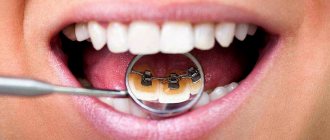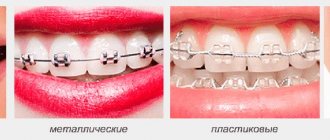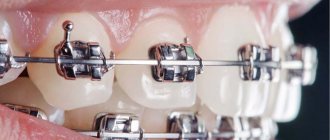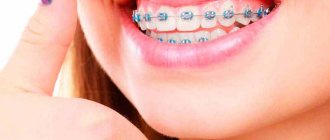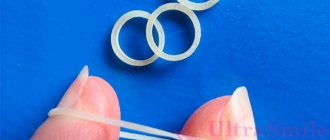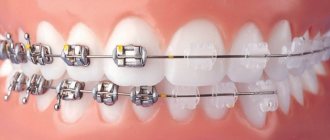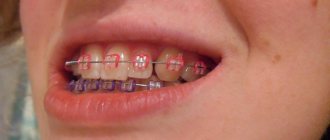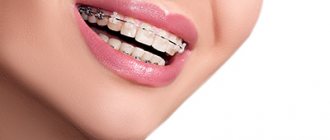Preparing for positioning
Fixing braces requires preparation. First, the patient will have an initial consultation with an orthodontist. After this, the dentist will prepare the oral cavity for attaching corrective structures.
Installation of braces is allowed only on healthy elements of the jaw arch. Preparation consists of several stages:
- Treatment of caries. It is necessary to detect carious lesions, even the smallest ones, and eliminate them.
- Checking installed seals. If your teeth were filled a long time ago, you need to check the strength of the old linings. If necessary, replace with new ones.
- Treatment of periodontal disease. The oral mucosa must be absolutely healthy. Therefore, even minor inflammatory processes can worsen after the installation of braces. We need to eliminate them.
- Remineralization. If the enamel on the teeth is thinned, the units are sensitive or there are cracks on them, it is necessary to carry out remineralization and strengthen the enamel.
Preparation for attaching braces, depending on the condition of the oral cavity, can last up to several months. During orthodontic therapy, it is necessary to take panoramic photographs of the dental system. Using them, the dentist will draw up a treatment plan and determine where to fix the locks. Before carrying out the bonding procedure, you need to make an appointment for professional teeth cleaning. The purpose of this dental service is to remove tartar and plaque. The braces should be fixed to a clean surface of the teeth. During fastening, nothing should interfere with gluing the structure.
Price issue
In many dental clinics, the cost for installing braces is highlighted as a separate line.
But there are also clinics where the amount for fixing the orthodontic system is included in the total cost of manufacturing the system. On average, this service is estimated at approximately 30% of the total cost of the braces system.
The installation price for products made from different materials will vary. The more expensive the system itself, the more expensive it will cost to install.
| Product material | Direct installation amount, rub. |
| Metal | From 10 000 |
| Ceramics | From 18000 |
| Sapphire | From 25000 |
The direct method is the most common installation method. The indirect method is currently used in a limited number of clinics. This is explained by its novelty and limited experience of specialists.
Due to the need to make a plaster model and special trays with the indirect method, its cost will increase by approximately 6-9 thousand rubles, compared to the direct method for each type of product material.
Direct technology for fixing braces
This method of attaching a corrective structure involves attaching it specifically to each tooth. The doctor installs a dilator into the patient’s oral cavity that holds the cheeks, lips, and tongue. Thus, it isolates the dental units from the soft tissues. Each tooth is cleaned with dental paste and a brush. Then, one by one, the doctor applies a special composition containing phosphoric acid. The product is harmless, does not damage the enamel, and creates microscopic roughness, which is necessary for reliable fixation of braces. Next, the orthodontist applies an adhesive bond system to the teeth, and a composite material to the brackets. Then he presses the bracket onto the tooth and the assistant uses a lamp to illuminate the composite.
Among the advantages of the method, it is worth noting the possibility of correcting structures. The downside is that such fastening is labor-intensive, since the procedure lasts approximately an hour and a half. It is uncomfortable for the patient to keep his mouth open for such a long time. The doctor will have to perform a large amount of work in one visit.
Useful tips
Correcting a bite with braces can take a long period of time. The speed and result of correction of defects depends on how accurately the patient follows all the doctor’s recommendations.
For the first time after fixing the orthodontic system, the patient should avoid solid foods and increased load on the jaws. Preference should be given to soft or liquid foods.
In the future, you must follow these recommendations:
- Visit your doctor regularly. This is necessary to assess the condition, adjust the pressure on the teeth, change ligatures and make the necessary adjustments;
- Careful oral hygiene. It is necessary to brush your teeth several times a day, after eating food. If there are no conditions to brush your teeth, you must rinse your mouth thoroughly;
- Use additional hygiene products (irrigator, floss, brush, etc.);
- Adhere to a special diet. The patient should exclude foods that are too hard, sticky or tough from the diet;
- Carry out periodic professional teeth cleaning;
- Eliminate bad habits.
Following these recommendations will help speed up the treatment process and will also reduce the likelihood of parts of the system coming off or being damaged.
Indirect technology for fixing bracket systems
This method differs from the previous one in that there is practically no need for the presence of the patient, which is very convenient for him. The procedure for fixing braces consists of the following steps:
- The orthodontist takes an impression, takes it to a dental technician in the laboratory, who makes an exact copy of the patient’s jaw - a plaster model, and covers it with an insulating varnish coating.
- For each tooth, the dentist attaches a bracket to a false tooth specifically in the position that is optimal for the patient. At the same time, the doctor can work as long as he needs, which allows him to attach dental structures to correct the dentition in a mode convenient for him.
- The doctor applies liquid hardening silicone to the bracket system, which is converted into a mouth guard. The braces and mouth guard are placed in water for 30 minutes, the varnish dissolves and the braces remain in the mouth guard.
The patient comes to see the dentist and he transfers the finished mouthguard into the oral cavity. Lighting and installation of braces is carried out in the required place.
One of the advantages of this method is the quick installation of braces. It will take no more than an hour to fix. There are also disadvantages, but few people pay attention to them, since the result is excellent. It takes time to make the model, mouthguard and system, this is the only drawback.
Thomas Pitts Table
The above methods of installing braces are based on the personal approach of the attending physician. In addition to this approach, a special protocol for fixing orthodontic systems has been developed.
This approach was developed and proposed by the American doctor Thomas Pitts. Pitts positions guarantee rapid correction of malocclusions.
For ease of understanding and use, these rules were translated by Dr. T. Castelanos into numerical parameters taking into account the length of the teeth.
The Pitts system consists of two parts and has the following scheme.
Upper jaw
| GPS-A | 1 | 2 | 3 | 4 | 5 | 6 | 7 |
| 8 | 4 | 4 | 4,5 | 4,5 | 4 | 3 | 3 |
| 9 | 4,5 | 4,5 | 5 | 5 | 4,5 | 3,5 | 3,5 |
| 10 | 5 | 5 | 5,5 | 5,5 | 5 | 4 | 4 |
| 11 | 5 | 5 | 6 | 6 | 5,5 | 4,5 | 4,5 |
Lower jaw
| GPS-A | 1 | 2 | 3 | 4 | 5 | 6 | 7 |
| 9 | 5 | 4,5 | 4,5 | 4 | 3,5 | 2,5 | 2 |
| 10 | 5,5 | 5 | 5 | 4,5 | 4 | 3 | 2 |
| 11 | 6,5 | 5,5 | 5,5 | 5 | 4,5 | 3,5 | 2,5 |
| 12 | 7 | 6 | 6 | 5 | 5,5 | 4 | 2,5 |
The installation location of the brackets is determined according to the following diagram:
- The length of the tooth crown is measured;
- The resulting figure is looked up in the GPS-A column;
- Next is the installation height according to the tooth standard.
This system helps to quickly determine the desired position for fixing braces, reduces installation time and reduces the likelihood of subjective errors.
Resilines fastening system
Fixing Resilines braces is another modern method practiced in dentistry. This is the most popular adhesive for attaching braces. Its adhesive properties are very soft and sticky, ideal for bonding any type of overbite correction. Using the composition it is possible to fix metal, sapphire and ceramic products. The adhesive quickly hardens under the influence of ultraviolet lamps. But until the braces are glued and the locks are installed, it remains soft. The metal arch can be installed immediately after attaching the locks.
Regardless of the chosen method, the orthodontist, first of all, needs to focus not on the method of fixation and type of brace system, but on the doctor’s expertise. With the right approach, any of the methods will be effective.
Content:
- Preparatory activities
- Options for installing braces 2.1. Direct method 2.1.1. How it goes 2.1.2. Advantages and disadvantages 2.2. Indirect method 2.2.1. Advantages and disadvantages
What result will be obtained after fixing braces depends on many factors. But the most important thing is that the installation of the leveling structure is done correctly. If you fix the device incorrectly, the teeth will close at the wrong angle. Then there will be no need to talk about any correction of the bite, no matter how long the patient walks with an “iron smile.”
Correction of the lower dentition
Braces are placed on the lower dentition only if the bite is almost perfect, and the upper teeth do not need to be corrected. As for the immediate reasons for installation, these are, for example, diseases of the ENT organs that negatively affect breathing and swallowing, jaw curvatures, and abnormal growth of lower molars. As you can see, this is further proof that the human body is a single structure in which everything is interconnected. And such an integrated approach, which the doctors of the Orto-Artel clinic adhere to in their work, allows us to achieve successful results in correcting teeth.
BIBLIOGRAPHY
1. Sarver, D.: Interactions of hard tissues, soft tissues, and growth over time, and their impact on orthodontic diagnosis and treatment planning, Am. J. Orthod. 148:380–386, 2015. 2. Sarver, D. and Jacobson, R.S.: The aesthetic dentofacial analysis, Clin. Plast. Surg. 34:369-394, 2007. 3. Peck, H. and Peck, S.: A concept of facial esthetics, Angle Orthod. 40:284-318, 1970. 4. Schabel, BJ; McNamara, J. A. Jr.; Baccetti, T.; Franchi, L.; and Jamieson, SA: The relationship between posttreatment smile esthetics and the ABO Objective Grading System, Angle Orthod. 78:579-584, 2008. 5. Kokich, V.O.; Kiyak, A.H.; and Shapiro, PA: Comparing the perception of dentists and laypeople to altered dental esthetics, J. Esth. Dent. 11:311-324, 1999. 6. Kokich, V.O.; Kokich, V. G.; and Kiyak, H.A.: Perceptions of dental professionals and laypersons to altered dental esthetics: Asymmetric and symmetrical situations, Am. J. Orthod. 130:141- 151, 2006. 7. Auger, T. A. and Turley, P. K.: The female soft tissue profile as presented in fashion magazines during the 1900s: A photographic analysis, Int. J. Adult Orthod. Orthog. Surg. 14:7-18, 1999. 8. Schlosser, JB; Preston, C. B.; and Lampasso J.: The effects of computer-aided anteroposterior maxillary incisor movement on ratings of facial attractiveness, Am. J. Orthod. 127:17-24, 2005. 9. Desai, S.; Upadhyay, M.; and Nanda, R.: Dynamic smile analysis: Changes with age, Am. J. Orthod. 136:310.e1-310.e10, 2005. 10. Dickens, S.; Sarver, D. M.; and Proffit, W.R.: The dynamics of the maxillary incisor and the upper lip: A cross-sectional study of resting and smile hard tissue characteristics, Am. J. Orthod. 3:313-320, 2002. 11. Chetan, P.; Tandon, P.; Singh, G. K.; Nagar, A.; Prasad, V.; and Chugh, V.: Dynamics of a smile in different age groups, Angle Orthod. 83:90-96, 2013. 12. Beall, AE: Can a new smile make you look more intelligent and successful? Dent. Clin. N. Am. 51:289-297, 2007. 13. Shaw, W. C.; Rees, G.; Dawe, M.; and Charles, C.R.: The influence of dentofacial appearance on the social attractiveness of young adults, Am. J. Orthod. 87:21-26, 1985. 14. Tjan, A.H.; Miller, G.D.; and The, JG: Some esthetic factors in a smile, J. Prosth. Dent. 51:24-28, 1984. 15. Sabri, R.: The eight components of a balanced smile, J. Clin. Orthod. 39:155-167, 2005. 16. Hulsey, C.: An esthetic evaluation of lip-teeth relationships present in the smile, Am. J. Orthod. 57:132-144, 1970. 17. Ackerman, J.; Ackerman, M. B.; Brensinger, C. M.; and Landis, JR: A morphometric analysis of the posed smile, Clin. Orthod. Res. 1:2-11, 1998. 18. Pitts, T.: Bracket positioning for smile arc protection, J. Clin. Orthod. 51:142-156, 2022. 19. Proffit, W. R.; Fields, H. W.; Larson, B.; and Sarver, DM: Contemporary Orthodontics, 6th ed., Elsevier, Philadelphia, 2022, p. 160.20. Dickens, S. T.; Sarver, D. M.; and Proffit, W.R.: Changes in frontal soft tissue dimensions of the lower face by age and gender, World J. Orthod. 3:313-320, 2002. 21. Harris, E.F.; Hassankiadeh, S.; and Harris, JT: Maxillary incisor crown-root relationships in different angle malocclusions, Am. J. Orthod. 103:48-53, 1993. 22. Bryant, R. M.; Sadowsky, P.L.; Dent, M.; and Hazelrig, J.B.: Variability in three morphological features of the permanent maxillary central incisor, Am. J. Orthod. 86:25-32, 1984. 23. Van Loenen, M.; Degrieck, J.; De Pauw, G.; and Dermaut, L.: Anterior tooth morphology and its effect on torque, Eur. J. Orthod. 27:258–262, 2005. 24. Mavroskoufis, F. and Ritchie, G. M.: Variation in size and shape between left and right maxillary central incisor teeth, J. Prosth. Dent. 43:254-257, 1980. 25. Chaushu, S.; Sharabi, S.; and Becker, A.: Tooth size in dentitions with buccal canine ectopia, Eur. J. Orthod. 25:485-491, 2003. 26. Balut, N.; Klapper, L.; Sandrik, J.; and Bowman, D.: Variations in bracket placement in the preadjusted orthodontic appliance, Am. J. Orthod. 102:62-67, 1992.
Stage two - treatment plan
When all the necessary information from various studies has been collected, the doctor needs time to process it. Data analysis, calculations and drawing up a treatment plan takes up to a week. The doctor can offer the patient several treatment methods that are suitable in a particular case and recommend the best option.
The choice of treatment plan rests with the patient. A qualified specialist will explain the difference and give a professional opinion, but the final decision is up to the patient. After agreeing on the treatment plan, an important stage begins - choosing a brace system. The modern market of orthodontic structures offers a variety of options in terms of materials, type of fastenings, and cost. The orthodontist will recommend the optimal solution based on the client’s wishes. You can request an example of a treatment plan from our clinic before starting treatment.
